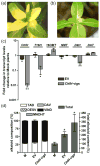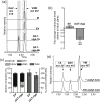A virus-induced gene silencing approach to understanding alkaloid metabolism in Catharanthus roseus
- PMID: 21802100
- PMCID: PMC3435519
- DOI: 10.1016/j.phytochem.2011.07.001
A virus-induced gene silencing approach to understanding alkaloid metabolism in Catharanthus roseus
Abstract
The anticancer agents vinblastine and vincristine are bisindole alkaloids derived from coupling vindoline and catharanthine, monoterpenoid indole alkaloids produced exclusively by the Madagascar periwinkle (Catharanthus roseus). Industrial production of vinblastine and vincristine currently relies on isolation from C. roseus leaves, a process that affords these compounds in 0.0003-0.01% yields. Metabolic engineering efforts to either improve alkaloid content or provide alternative sources of the bisindole alkaloids ultimately rely on the isolation and characterization of the genes involved. Several vindoline biosynthetic genes have been isolated, and the cellular and subcellular organization of the corresponding enzymes has been well studied. However, due to the leaf-specific localization of vindoline biosynthesis, and the lack of production of this precursor in cell suspension and hairy root cultures of C. roseus, further elucidation of this pathway demands the development of reverse genetics approaches to assay gene function in planta. The bipartite pTRV vector system is a Tobacco Rattle Virus-based virus-induced gene silencing (VIGS) platform that has provided efficient and effective means to assay gene function in diverse plant systems. A VIGS method was developed herein to investigate gene function in C. roseus plants using the pTRV vector system. The utility of this approach in understanding gene function in C. roseus leaves is demonstrated by silencing known vindoline biosynthetic genes previously characterized in vitro.
Copyright © 2011 Elsevier Ltd. All rights reserved.
Figures





Similar articles
-
Completion of the seven-step pathway from tabersonine to the anticancer drug precursor vindoline and its assembly in yeast.Proc Natl Acad Sci U S A. 2015 May 12;112(19):6224-9. doi: 10.1073/pnas.1501821112. Epub 2015 Apr 27. Proc Natl Acad Sci U S A. 2015. PMID: 25918424 Free PMC article.
-
Virus-induced gene silencing in Catharanthus roseus by biolistic inoculation of tobacco rattle virus vectors.Plant Biol (Stuttg). 2015 Nov;17(6):1242-6. doi: 10.1111/plb.12380. Epub 2015 Aug 30. Plant Biol (Stuttg). 2015. PMID: 26284695
-
Localization of tabersonine 16-hydroxylase and 16-OH tabersonine-16-O-methyltransferase to leaf epidermal cells defines them as a major site of precursor biosynthesis in the vindoline pathway in Catharanthus roseus.Plant J. 2005 Nov;44(4):581-94. doi: 10.1111/j.1365-313X.2005.02557.x. Plant J. 2005. PMID: 16262708
-
Enzymology of indole alkaloid biosynthesis in Catharanthus roseus.Indian J Biochem Biophys. 1996 Aug;33(4):261-73. Indian J Biochem Biophys. 1996. PMID: 8936815 Review.
-
Biotechnological advancements in Catharanthus roseus (L.) G. Don.Appl Microbiol Biotechnol. 2020 Jun;104(11):4811-4835. doi: 10.1007/s00253-020-10592-1. Epub 2020 Apr 17. Appl Microbiol Biotechnol. 2020. PMID: 32303816 Review.
Cited by
-
Biosynthesis and regulation of terpenoid indole alkaloids in Catharanthus roseus.Pharmacogn Rev. 2015 Jan-Jun;9(17):24-8. doi: 10.4103/0973-7847.156323. Pharmacogn Rev. 2015. PMID: 26009689 Free PMC article. Review.
-
The role of the Golden2-like (GLK) transcription factor in regulating terpenoid indole alkaloid biosynthesis in Catharanthus roseus.Plant Cell Rep. 2024 May 14;43(6):141. doi: 10.1007/s00299-024-03208-9. Plant Cell Rep. 2024. PMID: 38743349 Free PMC article.
-
Artificial microRNA mediated gene silencing in plants: progress and perspectives.Plant Mol Biol. 2014 Sep;86(1-2):1-18. doi: 10.1007/s11103-014-0224-7. Epub 2014 Jul 15. Plant Mol Biol. 2014. PMID: 25022825 Review.
-
Two Tabersonine 6,7-Epoxidases Initiate Lochnericine-Derived Alkaloid Biosynthesis in Catharanthus roseus.Plant Physiol. 2018 Aug;177(4):1473-1486. doi: 10.1104/pp.18.00549. Epub 2018 Jun 22. Plant Physiol. 2018. PMID: 29934299 Free PMC article.
-
Improved virus-induced gene silencing allows discovery of a serpentine synthase gene in Catharanthus roseus.Plant Physiol. 2021 Oct 5;187(2):846-857. doi: 10.1093/plphys/kiab285. Plant Physiol. 2021. PMID: 34608956 Free PMC article.
References
-
- Aerts RJ, Gisi D, de Carolis E, De Luca V, Baumann TW. Methyl jasmonate vapor increases the developmentally controlled synthesis of alkaloids in Catharanthus and Cinchona seedlings. Plant J. 1994;5:635–643.
-
- Burch-Smith TM, Anderson JC, Martin GB, Dinesh-Kumar SP. Applications and advantages of virus-induced gene silencing for gene function studies in plants. Plant J. 2004;39:734–746. - PubMed
-
- Courdavault V, Thiersault M, Courtois M, Gantet P, Oudin A, Doireau P, St-Pierre B, Giglioli-Guivarc’h N. CaaX-prenyltransferases are essential for expression of genes involvedin the early stages of monoterpenoid biosynthetic pathway in Catharanthus roseus cells. Plant Mol Biol. 2005;57:855–870. - PubMed
-
- De Carolis E, De Luca V. Purification, characterization, and kinetic analysis of a 2-oxoglutarate-dependent dioxygenase involved in vindoline biosynthesis from Catharanthus roseus. J Biol Chem. 1993;268:5504–5511. - PubMed
Publication types
MeSH terms
Substances
Grants and funding
LinkOut - more resources
Full Text Sources
Other Literature Sources

